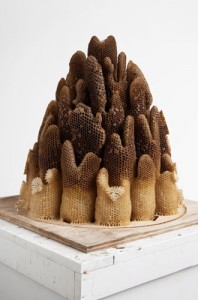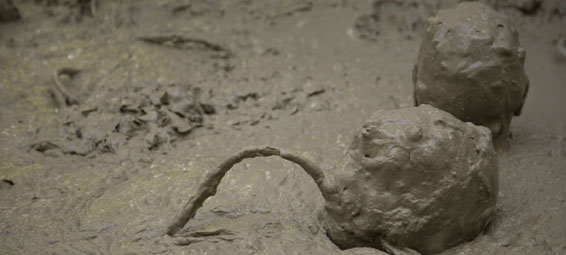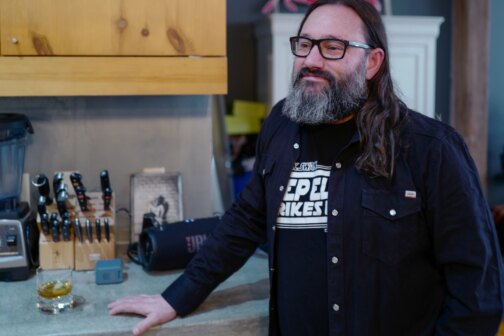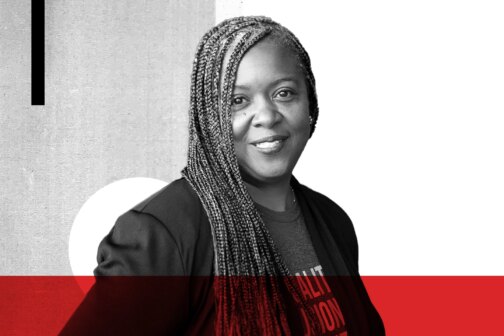As I approached the front doors of the Dallas Contemporary last Thursday night for the grand opening of Seedlings, I was enthusiastically greeted/steered by three volunteers at various points along my short trek from the parking lot. With the Contemporary’s banners billowing behind me, the double doors were opened by two more volunteers in anticipation of my arrival. I felt special, until I was asked whether I was on the list. Sorry, turns out I wasn’t that special after all, so I was ushered to a table where even more volunteers helped me create a name tag and sign up for the mailing list. Instead of paying the $10 non-member entrance fee into the opening I decided, amidst all of the hoopla, to go ahead and become a member. I mean, how could I turn down the accompanying free Dallas Contemporary yellow luggage tag?
By now the banners, the army of volunteers who had ushered me through the entrance process, the exchange of money and the impressive bios of the artists had fully aroused my anticipation of seeing a major show full of strong work, a show that would have the whole state buzzing the next morning, a show that could successfully follow up James Gilbert’s first in the new space, Warnings and Instructions.
Instead, I encountered emptiness: A shocking void that had most of us gawking like slack-jawed yokels asking, “Where is the work?” A David Brooks’ cherry picker piece greets you like a sentinel when you enter the building, but looking past that there is little to fill the massive space (and Brooks’ piece would have been much better suited outside where it could fully stretch out to give a sense of its great height). In Seedlings nothing takes command of the space, and because of this the show feels like an art fair — small works are separated by large distances as if different galleries were showcasing their artists.

The walls are sparsely covered with what seem to be leftovers from some fine, primarily New York, artists’ studios (with an Austinite and a West Coaster thrown in for good measure). The work on the walls is small and hence seems dropped down into the abyss, which made evaluating the artists represented difficult. And, like any good art fair it has something for everyone! Get your video art, your conceptual art, your traditional painting, your hipster drawing, and your big ol’ faux rock on the floor! And it’s only $10 to see!
Positively, however, thinking of Seedlings as a kind of fair makes this a great show to introduce our local galleries to some good out-of-town artists making very saleable work. I’d expect to see many of these artists in other local shows within a year or two.
One standout of the show is Hilary Harnischfeger, whom I hope is picked up down here so I can see a wider oeuvre of her work. She combines a wealth of materials such as paper, plaster, ink, glass, and rose quartz into work that reads more as object than painting. The surfaces are rich and luxurious and carry the luminosity of late Turners. But the work is injured by its placement in the gallery: two together on one big moveable wall and one on the reverse side. They are swallowed up.
Artist Christopher K. Ho gets lucky and is placed in the smaller annex space up front. He is placed here because his paintings are created with lotion and need air-conditioning to survive. His 6×8 inch paintings benefit greatly from the smaller space and allow the viewer to better focus on them. Using the lotion is a catchy gimmick, but he clearly has a sensitive touch with his medium and creates delicate airy versions of bits of Gainsborough paintings. Hilary Berseth’s beehive sculpture is also in this small, controlled space. This small space in the gallery could have easily been a separate show because the work of these two artists feed off of each other and creates the dialogue the guest curator, Regine Basha, must have desired for the whole show.

Ms. Basha is based in New York after a stint in Austin. She obviously knows many strong artists in the five boroughs and was able to convince a few of them to send some things down to Dallas. But for me, this show was all about names — New York curator, New York and LA artists, with David Brooks being the prize of the show since he is in Greater New York at P.S. 1 this year.
I admit that I am equally guilty of marketing names when I curate shows full of national and international artists — it brings in crowds and exposes local artists to fresh ideas and approaches. But names can’t carry a show. There has to be a consideration for a particular space. Seedlings ultimately seems about heralding bios and marketing the Contemporary in an attempt to justify spending the same amount of money as at the DMA and the Fort Worth Modern.
Seedlings would probably be a successful show if the artists involved had been able to fully commit to the space by making work for it, instead of shipping down items that would be better displayed in any other gallery space in this city. Even the video contribution from local film maker Quin Matthews, “Making of Seedlings,” which catalogues the crafting of the show, seems forced.
I am still a staunch supporter of the Dallas Contemporary. The space has the feel of DIA Beacon and Mass MOCA and presents many of the same opportunities, but also problems. It is an ominously empty space, intimidating for any artist or curator to try and fill with work, but that’s what makes it exciting. It is a great space for Dallas and has tremendous potential. It could be the shining beacon for contemporary artwork in the region, but it will require more curatorial imagination to see it come to life, hopefully without solving the spatial problem by further dividing it up and “gallerizing” it. It already has a few small areas that allow you to focus on smaller work and the addition of a few more moveable walls would help with future exhibits.
Let’s chock this show up to the sophomore slump and look forward to the next in what could be the best space for contemporary art in Dallas.
Main photo: Gilad Ratman, The 588 Project, 2009, Two channel video projection (still), 7:50 min
All photos courtesy of The Dallas Contemporary.






